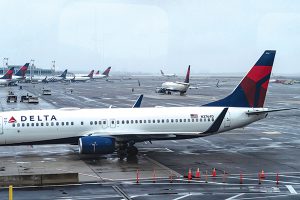Bloomberg
Delta Air Lines Inc fell short of profit expectations in the second quarter and said high operating costs will persist through the rest of the year, weighing on a possible rebound as carriers try to capitalise on continued strong travel demand.
So-called unit costs will climb as Delta extends constraints on its flying capacity for the remainder of 2022 in an effort to reduce flight delays and cancellations, the carrier said in a statement. Delta’s adjusted profit was $1.44 a share in the second quarter, missing the $1.64 average expected by analysts.
Delta’s shares tumbled 6.8% in New York, the biggest decliner in the S&P 500 Index. Other carriers, including American Airlines Group Inc, and cruise operators were among the worst performers in morning trading.
US airlines are trying to return to consistent profits after the rout in travel during the pandemic, and Delta said it expects “meaningful full-year profitability.†But elevated expenses and flight disruptions are limiting carriers’ ability to take advantage of higher fares, strong domestic demand and growing international travel.
“We’ve got to do everything we can, and we have been, to ensure we serve that demand and serve the quality of the operation and not try to grow beyond our means, which is tempting to do when you see the level of demand,†Chief Executive Officer Ed Bastian said in an interview. “I’d almost call it a seismic shift in where we’ve been over the last three or four months.â€
Delta is the first major US airline to report results for the second quarter, with United Airlines Holdings Inc and American Airlines set for the following week and Southwest Airlines Co on July 28. A group of 11 US carriers should report record quarterly revenue of $53.3 billion and combined pretax income of $4.2 billion for three months ended in June, according to Deutsche Bank analyst Michael Linenberg.
American Airlines revealed some preliminary expectations for the second quarter, standing by its earlier forecast for an increase in sales compared with pre-pandemic levels, despite the volatility that’s roiled the industry. While the Texas-based carrier also acknowledged costs would remain elevated, the commentary sent its shares surging.
US carriers could face another hurdle if inflation at its highest in four decades prompts consumers to rethink or avoid spending for flights. Fares declined by 1.8% in June on a monthly basis, after double-digit gains the prior three months, according to the consumer price index released. Delta hasn’t seen signs of a pullback in travel spending because of inflation, and Bastian said he expects “a reasonably healthy revenue outlook for the near to medium term for the industry.â€
Delta said it will hold flying capacity to its June level for the rest of the year, and the third quarter will be as much as 17% below 2019. That will contribute to non-fuel unit costs about 8 points above its original plan for the full year on 5 points less
capacity. Capacity in the third quarter will be down “more than initially planned, and as a result, ex fuel unit costs will be up,†Helane Becker, a Cowen analyst, said. Labour expenses, including overtime and added employees, along with higher costs per seat due to fewer flights, boosted expenses other than fuel.
Non-fuel costs to fly each seat a mile, a measure of efficiency, rose 22% in the second quarter compared to pre-pandemic levels and will also climb about 22% in third quarter, Delta said.
 The Gulf Time Newspaper One of the finest business newspapers in the UAE brought to you by our professional writers and editors.
The Gulf Time Newspaper One of the finest business newspapers in the UAE brought to you by our professional writers and editors.
